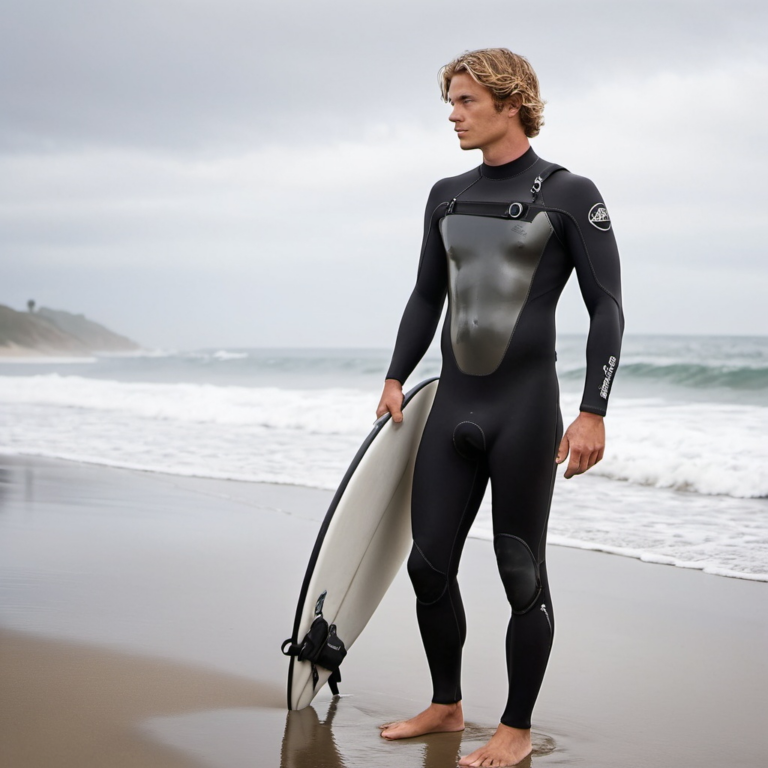Embarking on your surfing journey is an exhilarating experience, but it comes with its own set of challenges. One of the most crucial aspects for beginners is selecting the right wetsuit. A wetsuit isn’t just a piece of gear—it’s your armor against the elements, providing both warmth and flexibility as you tackle those first waves. In this guide, we’ll dive into the essentials of choosing a wetsuit that suits your needs, keeping you warm and comfortable while you master the art of surfing. Whether you’re braving the chilly waters of a northern coast or the temperate waves of a southern beach, finding the right wetsuit will enhance your surfing experience and help you stay in the water longer.
Overview
Selecting the perfect wetsuit for beginner surfers can feel like navigating a maze of neoprene, zippers, and varying thicknesses. Fear not, though!
First off, let’s talk about neoprene—the magic material that keeps you warm. This synthetic rubber comes in different grades, with thicker neoprene providing better insulation. For beginners, the most common thicknesses are 3/2mm and 4/3mm. A 3/2mm suit is generally sufficient for warmer waters, while a 4/3mm is ideal for chillier conditions.
Next up is wetsuit fit. A well-fitted wetsuit is like a second skin—it should be snug but not restrictive. Look for terms like “tight seal” around the ankles, wrists, and neck, and ensure there are no gaps where water can seep in. A suit that’s too loose will let cold water enter, diminishing its insulating properties and potentially making you uncomfortable.
When you’re choosing a wetsuit, you’ll also come across different wetsuit types. Here’s a quick rundown:
- Full Suit: This is the most common type, covering your entire body. It’s excellent for keeping you warm in cooler waters.
- Spring Suit: With short sleeves and legs, this type is perfect for warmer weather or when you want a bit more freedom of movement.
- Shorty: Ideal for the hottest conditions, this suit covers only the torso and has short sleeves and legs.
Another factor to consider is the wetsuit entry system. Wetsuits come with different types of entry systems, such as front zips, back zips, or even no zips (known as “zip-free” designs). Each has its pros and cons. For example, a front zip can be easier to get in and out of but may let in more water, while a back zip provides a better seal but might be trickier for some to manage alone.
Don’t overlook the seams! Seams are where different parts of the wetsuit are stitched together, and they play a crucial role in insulation. Look for terms like “glued and blind-stitched” or “seam-taped”—these indicate that the seams are reinforced to prevent water entry and enhance durability.
Additional features can also make a difference, such as thermal linings which add extra warmth or knee pads that offer protection and durability.
To summarize, here’s a checklist for choosing your beginner wetsuit:
- Thickness: 3/2mm or 4/3mm depending on water temperature.
- Fit: Snug with no gaps.
- Type: Full suit, spring suit, or shorty based on climate.
- Entry System: Front zip, back zip, or zip-free.
- Seams: Glued and blind-stitched or seam-taped.
- Additional Features: Thermal linings and knee pads.
Where to Buy Your Beginner Surf Wetsuit
Choosing the right wetsuit is crucial, but finding the perfect place to buy it can be just as important. With so many options available—from specialized surf shops to online retailers—it’s essential to know where to look. In this section, we’ll explore different purchasing avenues, comparing their benefits and drawbacks to help you make an informed choice.
In-Store vs. Online Shopping
In-Store Shopping: Shopping for a wetsuit in-store allows you to physically try on different models and get a feel for their fit and comfort. Additionally, in-store experts can provide personalized advice and recommendations based on your needs.
Pros:
- Try Before You Buy: You can check the fit and comfort of the wetsuit before purchasing.
- Immediate Purchase: No waiting for shipping; you can start using your wetsuit right away.
- Expert Advice: Sales staff can offer guidance on fit, features, and brands.
Cons:
- Limited Selection: Physical stores may not have as wide a variety as online retailers.
- Higher Prices: In-store prices can be higher due to overhead costs.
Online Shopping: Buying a wetsuit online offers the convenience of browsing a vast selection of brands and models from the comfort of your home. Many online retailers provide detailed size guides and customer reviews to help you make a decision.
Pros:
- Wide Selection: Access to a broad range of brands and styles.
- Competitive Prices: Often, online retailers offer lower prices and discounts.
- Convenience: Shop from anywhere, anytime.
Cons:
- Fit Uncertainty: It’s harder to assess the fit and comfort without trying the wetsuit on.
- Shipping Time: You’ll have to wait for the wetsuit to be delivered, and returns can be cumbersome.
Where to Buy: Comparison Table
Here’s a comparative look at some popular buying options for wetsuits:
| Retailer | Pros | Cons | Recommended For |
| Local Surf Shops | Personalized advice, try on before buying, immediate purchase | Limited selection, potentially higher prices | Hands-on shoppers looking for expert advice |
| Specialty Outdoor Stores | Good selection, knowledgeable staff, immediate purchase | May be more expensive than online | Those who want to see multiple brands in one place |
| Online Surf Retailers | Wide selection, often lower prices, customer reviews | Cannot try on, shipping and return delays | Savvy shoppers who know their sizes and preferences |
| Major E-commerce Sites | Vast selection, competitive pricing, easy returns | Quality and service may vary, risk of incorrect sizing | Budget-conscious buyers seeking variety |
Top Recommendations
- Local Surf Shops: If you have a surf shop nearby, it’s worth visiting for a personal touch. Staff can guide you through options and ensure you get a wetsuit that fits just right. Plus, you’ll support local businesses.
- Specialty Outdoor Stores: Stores like REI or Patagonia often have a range of wetsuits and knowledgeable staff. They provide a good balance between selection and expertise.
- Online Surf Retailers: Websites like Surfline, Wetsuit Warehouse, and Evo offer extensive selections and detailed size guides. Look for retailers with easy return policies in case the fit isn’t perfect.
- Major E-commerce Sites: Amazon and eBay can be good sources for discounts, but be sure to check the seller’s ratings and return policies to avoid any issues with your purchase.
Key Considerations for Buying a Beginner Surfing Wetsuit
When diving into the world of wetsuits, several key factors should guide your purchase decision. For beginners, understanding these considerations can help you select a wetsuit that enhances your surfing experience and keeps you comfortable in various water conditions. Here’s a closer look at what to keep in mind:
- Water Temperature: One of the primary factors influencing your wetsuit choice is the water temperature where you’ll be surfing. For warmer waters (around 65-75°F or 18-24°C), a thinner wetsuit like a 3/2mm or even a spring suit might suffice. Conversely, for colder waters (below 65°F or 18°C), you’ll need a thicker wetsuit (4/3mm or even 5/4mm) to maintain warmth. Understanding the temperature range of your local surf spots will help you pick the right thickness.
- Wetsuit Material: Neoprene is the standard material used in wetsuits due to its flexibility and insulation properties. However, not all neoprene is created equal. Higher-grade neoprene offers better flexibility, warmth, and durability. Look for terms like “Ultra-Stretch” or “E3 Neoprene,” which indicate high-quality materials that provide excellent performance.
- Fit and Comfort: The fit of a wetsuit is crucial. It should be snug but not so tight that it restricts movement. A well-fitting wetsuit ensures minimal water entry, which helps retain body heat. Pay attention to features like adjustable neck seals and flexible panels that enhance comfort and mobility.
- Seams and Construction: Seams are a critical component of a wetsuit’s construction. Look for wetsuits with “blind-stitch” seams or “Glued and Blind-Stitched” (GBS) seams, which prevent water from seeping through and provide better insulation. Seam construction impacts both the durability and warmth of the wetsuit.
- Closure System: Wetsuits come with various closure systems, including front zippers, back zippers, and zip-free designs. Front zippers can be easier to get in and out of, while back zippers offer a secure fit. Zip-free designs eliminate potential water entry points but might be more challenging to put on and take off.
- Additional Features: Consider features such as thermal linings for extra warmth, reinforced knee pads for durability, and extra padding in high-wear areas. These additions can enhance comfort and extend the life of your wetsuit.
FAQs
What’s the difference between a wetsuit and a drysuit?
Wetsuits and drysuits, while sharing the common goal of thermal protection in aquatic environments, function distinctly.
Wetsuits operate on a principle of heat retention by encapsulating a minimal volume of water between the wearer’s skin and the suit’s fabric. The body’s natural warmth gradually elevates the temperature of this trapped water, creating an insulating barrier. Constructed primarily from neoprene, wetsuits offer effective thermal regulation across a spectrum of water temperatures.
A drysuit, on the other hand, is designed to keep you completely dry. Drysuits are used in colder conditions or when extended periods of immersion are expected. They usually require additional insulating layers worn underneath.
How do I choose the right wetsuit thickness?
The thickness of your wetsuit depends largely on the water temperature where you’ll be surfing. Generally:
- 3/2mm Wetsuits: Suitable for warmer waters (65-75°F or 18-24°C). They offer a balance of warmth and flexibility.
- 4/3mm Wetsuits: Ideal for cooler waters (55-65°F or 13-18°C). They provide additional insulation for extended exposure.
- 5/4mm or Thicker: Best for very cold waters (below 55°F or 13°C). They offer maximum warmth but may be less flexible.
Check local surf conditions and water temperatures to determine the appropriate thickness for your needs.
What should I consider when buying a wetsuit for surfing?
When purchasing a wetsuit for surfing, consider the following:
- Fit: The wetsuit should fit snugly but not restrict your movement. Look for a suit with adjustable seals at the neck, wrists, and ankles.
- Material: High-quality neoprene provides better insulation and flexibility. Look for terms like “Ultra-Stretch” or “Super-Stretch” for enhanced performance.
- Seam Construction: Seams should be “blind-stitched” or “Glued and Blind-Stitched” (GBS) to prevent water entry.
- Closure System: Decide between front zippers, back zippers, or zip-free designs based on your preference for ease of use and water entry prevention.
- Additional Features: Consider features like thermal linings, reinforced knee pads, and extra padding for added comfort and durability.
How do I care for and maintain my wetsuit?
Proper care extends the life of your wetsuit. Here are some tips:
- Rinse After Use: Rinse the wetsuit in cold, fresh water immediately after use to remove salt, sand, and chlorine.
- Dry Properly: Hang the wetsuit to dry in a shaded, well-ventilated area. Avoid direct sunlight, which can degrade the neoprene.
- Store Correctly: Store the wetsuit flat or on a wide hanger to maintain its shape. Avoid folding or compressing it.
- Avoid Harsh Chemicals: Use wetsuit-specific cleaners and avoid harsh detergents or bleach.
How do I find the right wetsuit size?
To find the right size, refer to the manufacturer’s size chart, which typically includes measurements for height, weight, and chest circumference. For the best fit:
- Measure Yourself: Take accurate measurements of your height, weight, chest, and waist.
- Consult the Size Chart: Compare your measurements with the size chart provided by the wetsuit manufacturer.
- Consider Brand Variations: Sizing can vary between brands, so it’s important to check the specific chart for each brand.
Conclusion
Navigating the world of wetsuits can initially seem daunting, especially for beginners stepping into the surfing scene. However, with a clear understanding of key considerations such as water temperature, wetsuit thickness, fit, and additional features, you can make a well-informed choice that enhances your surfing experience.
Choosing the right wetsuit is more than just picking a size; it’s about ensuring comfort, flexibility, and adequate protection against the elements. Whether you’re surfing in warm, temperate, or cold waters, selecting a wetsuit that matches your needs will help you stay in the water longer and enjoy your time on the waves.
Remember, a well-fitting wetsuit not only keeps you warm but also boosts your confidence as you tackle those first waves. As you prepare for your surfing adventures, keep these insights in mind to find a wetsuit that’s not just functional but also enhances your enjoyment of the sport. Happy surfing!
To continue your research, read the following articles:




